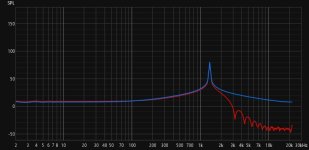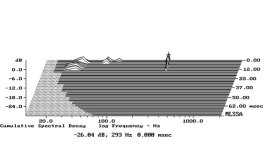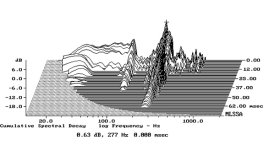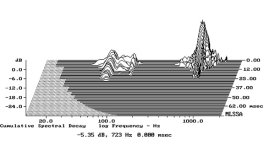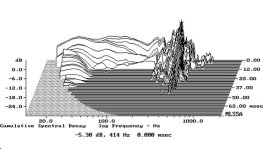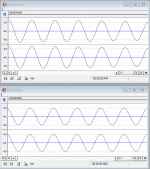(5) Forgot to mention magnetic hysteresis distortion/noise 🙂
https://purifi-audio.com/blog/tech-notes-1/this-thing-we-have-about-hysteresis-distortion-3
https://purifi-audio.com/blog/tech-notes-1/this-thing-we-have-about-hysteresis-distortion-3
For me its a little different. As I mentioned before I use Sound Lab large area electrostatic speakers. Perhaps some of the lowest distortion speakers made. If there is a problem somewhere with the electronics then very likely its going to be audible.
Aah, good for you. Large Sound Labs are one of the few commercial home audio speakers I'd still like to hear. Big stat fan...still have Acoustat-X , ML CLS, and Stax Lambda Pro signature. It was playing with all those in my 'purist' years that i finally decided if I did hear any difference in DACs or regulated power supplies or all the other electronics and tweaks, it had the pragmatic effect of being just another expensive EQ.
Anyway....
I don't want to be mysterious so I better just cut to the chase. (1) FFTs have an averaging effect, the larger the FFT size (i.e the finer the frequency resolution) the more its giving an average measurement. (2) Standard spectral analysis doesn't show phase information in the plots, despite humans having some ability to hear phase at low frequencies, (3) Spectral lines have noise skirts at the base of the line; the skirts contain information about phase noise and amplitude noise that have become intermodulated with the audio signal, and (4) the height of spectral lines is not in general a measure of the signal's peak amplitude level nor of its audibility; its only a measure of peak amplitude and perhaps of audibility (neglecting masking) in the special the case of PSS (Periodic Steady State) signals, such as fixed level sine waves we use as test signals. Even if the test signals are PSS, it isn't always necessarily the case that the system response is PSS.
I agree with much of the above. Imo, the mainstream community is fixated on frequency domain response, while largely ignoring the time domain.
But again, this says more about the measurer, than about the ability of measurements.
I think the measurement problems you describe apply to speakers, and often to filters, both IIR and FIR. Modulating pink noise for use with dual channel transfer and impulse response measurements can show reality better than straight sine sweeps ime.
I personally could care less how DACs and reasonably decent amps test under that ...again, bigger fish to fry ...but that's just me.
Sorry, you are correct. I have a new PC and didn't increase the default 2K FFT size in Sound Forge. But even when set to the max 64K the FFT displays are different. And they don't look anything like you and that web site show. Try it yourself with whatever audio program you have.Doesn't look right at all. Should look like the spectrum shown in the article with a carrier and modulation sidebands (looks like your FFT bins are too wide to resolve the separate frequencies):
Wrong windowing, looks like now. Will it work with no window? Do you know how to tell from looking at the wave files? What you do is loop them, if you know what that is. If the tail end of the file meets up smoothly with the beginning of the next looped version, then probably good without windowing. In fact, windowing is just needed so that there are not abrupt discontinuities where the beginning and end of the file would line up if looped.
Last edited:
True. Unfortunately people are often not taught about enough of the details or implications of measurement techniques....this says more about the measurer, than about the ability of measurements.
One area that is only starting to become better understood is how to disentangle noise skirt intermodulated phase noise and the associated noise sidebands/intermodulation products, from the corresponding amplitude noise effects. Also, regarding human interpretation, the low level appearance of noise skirts does not mean the effects are necessarily of low peak level. They can be every bit as high peak level as the central spectral line peak. It may not be heard as a nonlinear distortion either. Noise skirts that arise from running an audio signal through a resistor with high-ish Excess/Current Noise may take on a rather strange sound effect since the intermodulated noise tends to have a 1/f-like spectrum.
Last edited:
I firmly believe that we can measure everything, we may not know how to interpret the data or have the righ protocols yet (altough i'm sure we already know most), but we can measure what the amp/speaker/... does.
But what we can't measure is how our hearing system (ears and brain) process it. That's what i think why we keep having these discussions. How we hear is subjective by definition, so unmeasurable. So we can only focus on what we can measure and learn how to work with the data better. Most like clean sound, but statistic studies (oa those of Toole & Olive at Harman) show that there is a significant minority that like a bit harmonic distortion.
And our ears have a max resolution of about 96dB snr (or sinad). So all that goes above is transparent concerning noise and distortion. Between 96 and 40-50dB it's not obvious but it influences what we hear (colours the sound). Idem with frequencey respons, most don't hear above 15kHz, so ...
Amps and other electronics can be made fully transparent today, modern dacs and higher end class D amps are that. But speakers not, speakers are the weak point in any audio system. We have standards to measure them, and i don't think they are perfect, but if you want to challenge them, you need to do it scientificly like Andy said, not showing graphs without context or info on how they were made or make assumptions without scientific background. I see to many claims without decent scientific background made by many, even reputed people here. I'm don't think i'm skilled enough to go that deep, but i like to learn, and I don't learn much here as the science is largely missing, it became a flamewar between some big ego's...
But what we can't measure is how our hearing system (ears and brain) process it. That's what i think why we keep having these discussions. How we hear is subjective by definition, so unmeasurable. So we can only focus on what we can measure and learn how to work with the data better. Most like clean sound, but statistic studies (oa those of Toole & Olive at Harman) show that there is a significant minority that like a bit harmonic distortion.
And our ears have a max resolution of about 96dB snr (or sinad). So all that goes above is transparent concerning noise and distortion. Between 96 and 40-50dB it's not obvious but it influences what we hear (colours the sound). Idem with frequencey respons, most don't hear above 15kHz, so ...
Amps and other electronics can be made fully transparent today, modern dacs and higher end class D amps are that. But speakers not, speakers are the weak point in any audio system. We have standards to measure them, and i don't think they are perfect, but if you want to challenge them, you need to do it scientificly like Andy said, not showing graphs without context or info on how they were made or make assumptions without scientific background. I see to many claims without decent scientific background made by many, even reputed people here. I'm don't think i'm skilled enough to go that deep, but i like to learn, and I don't learn much here as the science is largely missing, it became a flamewar between some big ego's...
I'm don't think i'm skilled enough to go that deep, but i like to learn, and I don't learn much here as the science is largely missing,
You should rely on your common sense and the tools available. Nevermind the ones pretending to be scientists.
"A good tree can not bear bad fruit, nor can a rotten tree bear good fruit."
Last edited:
You should rely on your common sense and the tools available. Nevermind the ones pretending to be scientists.
It's not that easy for hobbyists without a technical grounding to distinguish between posts from those with technical understanding and those giving the appearance of technical understanding. In the case of this thread we have plausible looking posts saying speakers do audibly couple to what they are standing on and plausible looking posts saying they do not. For a DIY speaker hobbyist the topic is of significance. Not as important as some other things but of significance. So how would a non-technical hobbyists sort it out reliably? Unreliably is easy enough by simply plumping for the statements which seem the most plausible and for some that is likely good enough for a hobby. But reliably?
Copy. Copy the model. Feed it with music. Do tell
I gave you the figure to copy; you can do the same with elastomer + compressed air, as the vectors are the same, but still the rubber suspension is needed to make tweeter and midrange isolated from the woofer chamber.
I gave you the figure to copy; you can do the same with elastomer + compressed air, as the vectors are the same, but still the rubber suspension is needed to make tweeter and midrange isolated from the woofer chamber.
Here is a spectrum of one of the files downloaded from Purifi example page, as viewed in Arta:

Here is the spectrum shown in the Purifi example:

They look about the same in terms of displayed frequencies, as they should. Don't know why other software doesn't seem to be able to get the FFT settings close enough.
Purifi blog page url: https://purifi-audio.com/blog/tech-notes-1/doppler-distortion-vs-imd-7
Here is the spectrum shown in the Purifi example:
They look about the same in terms of displayed frequencies, as they should. Don't know why other software doesn't seem to be able to get the FFT settings close enough.
Purifi blog page url: https://purifi-audio.com/blog/tech-notes-1/doppler-distortion-vs-imd-7
Last edited:
It might help if you could quote the specific posts you are referring to.In the case of this thread we have plausible looking posts saying speakers do audibly couple to what they are standing on and plausible looking posts saying they do not.
Use an online function generator to sweep moderate level tones through the speaker of interest with a hand on a side wall. When I did this with an old PSB Alpha Mite project cabinet this tiny speaker went off dramatically around 260 Hz. (Claiming only instruments can validate the presence of vibrations is comically misanthropic.) At a minimum it indicates if it's worth consideration at all.So how would a non-technical hobbyists sort it out reliably?
the right instruments to measure
Mechanics stethoscope is a very quick tool to detect excited resonances and also is not expensive. Play music loud and listen to the speaker panels (or whatever). Will give immediate qualitative data. Quickly tells you where you have problems.
Quantitative measurement takes more time, effort, and tools. Laser inferometry or an accelarometre attached to a panel. The latter only samples one point at a time and will add a mass (Stereophile has lots of examples). The former can scan enire sides.
Examples from Stereophile shown here, but remember, it is just one spot on one cabinet wall.
I have speculated that a mic capsule could be stuck into the stethescope tube and get some quantitative data.
dave
Attachments
To save space I didn't quote your entire post, but I agree with what you wrote. As I have said a few times now, there is no magic in audio. And there is nothing regarding fidelity that is not understood. Hearing perception is a different story. Measuring is highly repeatable, listening not nearly so much. The same music or other sounds played five minutes apart can sound very different. Not only because of hearing frailty, but also because very small head movements change the response at both ears.I firmly believe that we can measure everything, we may not know how to interpret the data or have the righ protocols yet
I looked at the AM and FM FFT spectrums again with the FFT size at 65K max, and it does now show the same spikes if you zoom way in on the 1.3 KHz fundamental. But again, they sound different and so must measure different if you measure the right thing. In this case the simple waveform view below clearly shows the differences. So again, the files sound different and measuring is not exactly the same as was claimed.
Attachments
Not necessarily so, although many people believe the above to be true. There appears to be some non-scientific dogma associated with the belief with regards to audible transparency being assured given sufficiently good SINAD numbers.Amps and other electronics can be made fully transparent today, modern dacs and higher end class D amps are that.
A paper is attached which shows recent progress in measuring things affecting dac performance that virtually nobody is measuring today. IMHO, there is no scientific proof that what is being measured today is all there is that matters in terms of human perceptual abilities, given an otherwise very clean system. If someone thinks there is scientific proof that audible transparency can be guaranteed solely as a function of SINAD measurements, I would be very grateful to see it.
Attachments
Last edited:
- Home
- Loudspeakers
- Multi-Way
- What's the problem with modern proper loudspeaker cabinets decoupling?
